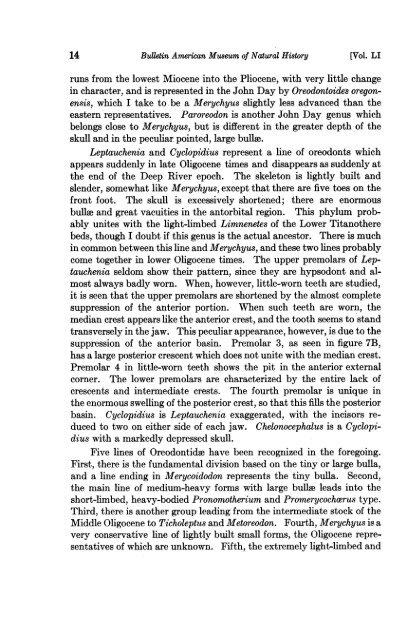View/Open - American Museum of Natural History
View/Open - American Museum of Natural History
View/Open - American Museum of Natural History
You also want an ePaper? Increase the reach of your titles
YUMPU automatically turns print PDFs into web optimized ePapers that Google loves.
14 Bulletin <strong>American</strong> <strong>Museum</strong> <strong>of</strong> <strong>Natural</strong> <strong>History</strong><br />
[Vol. LI<br />
runs from the lowest Miocene into the Pliocene, with very little change<br />
in character, and is represented in the John Day by Oreodontoides oregonensis,<br />
which I take to be a Merychyus slightly less advanced than the<br />
eastern representatives. Paroreodon is another John Day genus which<br />
belongs close to Merychyus, but is different in the greater depth <strong>of</strong> the<br />
skull and in the peculiar pointed, large bullae.<br />
Leptauchenia and Cyclopidius represent a line <strong>of</strong> oreodonts which<br />
appears suddenly in late Oligocene times and disappears as suddenly at<br />
the end <strong>of</strong> the Deep River epoch. The skeleton is lightly built and<br />
slender, somewhat like Merychyus, except that there are five toes on the<br />
front foot. The skull is excessively shortened; there are enormous<br />
bullaw and great vacuities in the antorbital region. This phylum probably<br />
unites with the light-limbed Limnenetes <strong>of</strong> the Lower Titanothere<br />
beds, though I doubt if this genus is the actual ancestor. There is much<br />
in common between this line and Merychyus, and these two lines probably<br />
come together in lower Oligocene times. The upper premolars <strong>of</strong> Leptauchenia<br />
seldom show their pattern, since they are hypsodont and almost<br />
always badly worn. When, however, little-worn teeth are studied,<br />
it is seen that the upper premolars are shortened by the almost complete<br />
suppression <strong>of</strong> the anterior portion. When such teeth are worn, the<br />
median crest appears like the anterior crest, and the tooth seems to stand<br />
transversely in the jaw. This peculiar appearance, however, is due to the<br />
suppression <strong>of</strong> the anterior basin. Premolar 3, as seen in figure 7B,<br />
has a large posterior crescent which does not unite with the median crest.<br />
Premolar 4 in little-worn teeth shows the pit in the anterior external<br />
corner. The lower premolars are characterized by the entire lack <strong>of</strong><br />
crescents and intermediate crests. The fourth premolar is unique in<br />
the enormous swelling <strong>of</strong> the posterior crest, so that this fills the posterior<br />
basin. Cyclopidius is Leptauchenia exaggerated, with the incisors reduced<br />
to two on either side <strong>of</strong> each jaw. Chelonocephalus is a Cyclopidius<br />
with a markedly depressed skull.<br />
Five lines <strong>of</strong> Oreodontidae have been recognized in the foregoing.<br />
First, there is the fundamental division based on the tiny or large bulla,<br />
and a line ending in Merycoidodon represents the tiny bulla. Second,<br />
the main line <strong>of</strong> medium-heavy forms with large bullse leads into the<br />
short-limbed, heavy-bodied Pronomotherium and Promerycochoerus type.<br />
Third, there is another group leading from the intermediate stock <strong>of</strong> the<br />
Middle Oligocene to Ticholeptus and Metoreodon. Fourth, Merychyus is a<br />
very conservative line <strong>of</strong> lightly built small forms, the Oligocene representatives<br />
<strong>of</strong> which are unknown. Fifth, the extremely light-limbed and

















